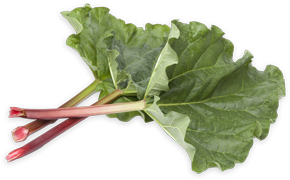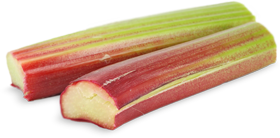חלק הצמח | איכויות | רכיבים פעילים | התוויות | מינונים | רגישות | תופעות לוואי |
מינון יתר | אזהרות | התוויות נגד | רעילות | אינטראקציות | הריון | הנקה
המשמעות המילולית של השם הסיני (Da huang) הינה ״צהוב גדול״.
מונוגרף זה מתייחס למיני הריבס הנהוגים בשימוש רפואי (R. officinale, R. palmatum ו-R. tanguticum), ולא למין הנצרך כירק מאכל (R. rhubarbarum).
ריבס הינו צמח רב שנתי. מוצאו בסין.
המין R. palmatum מותר לשיווק בבתי מרקחת בלבד, ואילו שאר המינים שנהוגים בשימוש רפואי, אינם מופיעים באף אחת מרשימות הצמחים של משרד הבריאות הישראלי.


חלק הצמח בשימוש
שורש, קנה שורש.
איכויות
טמפרטורה: קריר.
לחות: יבש.
טעם:, מריר, אסטרינג׳נט.
רכיבים פעילים עיקריים
אנטראקינונים (2-12% מסך הצמח; מתוכם 60-80% כוללים Aloe-emodin, chrysophanol, emodin, physcion, rhein, ועוד 10-25% sennosides), טאנינים (5-10% מסך הצמח, ביניהם rheum tannic acid, gallic acid, catechin, gallotannins), סידן אוקסלט (6%).
בחלק מהמינים מופיעים בנוסף גם פלבונואידים, פנולים וסטרולים.
התוויות
עצירות.
קיימות עדויות כי מינון נמוך ביותר של הצמח עשוי לסייע במקרים של שלשול.
מינונים
תמצית נוזלית בריכוז 1:3, 45% אלכוהול – 2-5 מ״ל למנת נטילה (עד 15 מ״ל ביום).
תמצית יבשה – תלוי בריכוז התמצית. מינון המקביל ל- 0.5-1.5 גרם צמח למנת נטילה (עד 4.5 גרם צמח ביום).
מרתח* – 2-4 גרם למנת נטילה (עד 12 גרם ביום).
בפורמולה – 20-25%.
*על פי הפרמקופיאה הסינית (בנסקי), בישול הצמח למשך יותר מ-10 דקות, מפחית מפעילותו המשלשלת.
לטיפול בעצירות יש להשתמש בחומר גולמי ככל הניתן(1).
רגישות
לא ידועה רגישות מיוחדת לריבס.
תופעות לוואי
תופעות לוואי עלולות לכלול למידע השלם למנויים
מוטב לשלב נטילת ריבס עם למידע השלם למנויים
שימוש ארוך טווח במשלשלים המכילים אנטראקינונים עלול להוביל ל למידע השלם למנויים
כמו כן, שימוש חוזר ונשנה במשלשלים עלול ל למידע השלם למנויים
מינון יתר
מינון יתר עלול לגרום ל למידע השלם למנויים
שלשול יתר עלול להוביל ל למידע השלם למנויים
אזהרות וצעדי מנע
משך השימוש – למידע השלם למנויים
אבנים בכליוֹת – למידע השלם למנויים
חסרים תזונתיים – למידע השלם למנויים
הפרדת נטילה – למידע השלם למנויים
דימומים – למידע השלם למנויים
שתן – למידע השלם למנויים
חיתולים במבוגרים – למידע השלם למנויים
מחלות כבד - למידע השלם למנויים
התוויות נגד
ריבס אסור לשימוש במצבים של למידע השלם למנויים
ריבס אינו מיועד לטיפול בעצירות ממקור של למידע השלם למנויים
אין לערוך שימוש בריבס כאשר למידע השלם למנויים
ריבס אינו מיועד לשימוש ב למידע השלם למנויים
ברפואה הסינית המסורתית, ריבס אסור לשימוש במצבים של למידע השלם למנויים
רעילות
שימוש ארוך טווח במשלשלים המכילים אנטראקינונים חשוד כגורם להיווצרות דלקת כבד(2,3,29,30).
מאמר סקירה (יולי, 2016)(60) שסקר דווחים על רעילות לכבד בעקבות שימוש בצמחים הנהוגים ברפואה הסינית בין השניםם 2009-2014 בסינגפור, דווח על למידע השלם למנויים
תגובות הדדיות עם תרופות / צמחי מרפא / תוספי תזונה
השפעה על חילוף חומרים תרופתי
שימוש במשלשלים ממריצים עלול להפחית את זמן המעבר של חומרים שונים במעיים, ובעקבות כך לגרום לירידה בספיגתם(2,3,12,22,24).
כמו כן, בתנאי מעבדה(41,42) נמצא שתמציות שונות של מיני ריבס הגבירו את פעילות האנזימים CYP2D6, CYP3A, CYP1A2 ו-CYP2E1, אך עיכבו את פעילות האנזים CYP2C6.
במחקר מעבדה נוסף(54), מיצוי של ריבס עיכב את פעילות האנזים CYP3A. ואילו רכיבים שונים שנגזרו מהצמח(55,56) הגבירוו את פעילות האנזימים CYP1A1 ו-CYP1B1, ועיכבו את פעילות האנזימים CYP1A2, CYP2C9, CYP2D6, CYP2E1 ו-CYP3A4.
במודל היפוך מעיים של חולדות(54), מיצוי של ריבס עיכב משמעותית את פעילות המשאבה החלבונית P-gp (גליקופרוטאין P). עיכוב המשאבה עשוי להעלות ריכוזן של תרופות ולהפחית עמידות לתרופות. בתנאי מעבדה(57), הוספת מיצוי ריבס לתאי סרטן צוואר הרחם (תאי HeLa) שפתחו עמידות לתרופות כימותרפיות, הגבירה את רגישות התאים לתרופה הכימותרפית Paclitaxel על ידי עיכוב המשאבה P-gp (גליקופרוטאין P).
לא נערכו מחקרים קליניים ולא ברורה הרלוונטיות הקלינית של ממצאים אלו.
גלִיקוזידים קרדִיאליים (כדוגמאת תרופות להסדרת קצב הלב) למידע השלם למנויים
תרופות משתנות למידע השלם למנויים
קורטיקוסטרואידים, לרבות הצמח שוּש קירח (Glyִcyrrhiza glabra) למידע השלם למנויים
מעכבי ACE (לטיפול באי ספיקת כליות כרונית) למידע השלם למנויים
חוסמי תעלות סִידן למידע השלם למנויים
תרופות נוגדות פרכוסים למידע השלם למנויים
רדיותרפיה למידע השלם למנויים
הריון
ריבס אסור לשימוש במהלך ההריון, ובמיוחד במהלך הטרימסטר הראשון(2,3,12-14,21,23,24,48).
95 נשים שסבלו מעצירות טופלו באמצעות פורמולה משלשלת (Laxariston) שהכילה ריבס(49). 14 מתוכן היו למידע השלם למנויים
באופן תיאורטי, קיימת אפשרות ש למידע השלם למנויים
הנקה
ריבס אסור לשימוש במהלך תקופת ההנקה(1-3,12,21,24,51).
קיים חשש ש למידע השלם למנויים
אמנם קיים מחקר בודד שנערך בקרב נשים מניקות בשנת 1970 בו למידע השלם למנויים
מקורות
- Bensky D, Gamble A, Kaptchuk T. Chinese Herbal Medicine Materia Medica. Vista, CA: Eastland Press, 1993. https://www.eastlandpress.com/products/eastland-herb.
- WHO. Rhizoma Rhei. WHO Monographs on Selected Medicinal Plants. 1 vol. Geneva: World Health Organization; 1999. http://apps.who.int/medicinedocs/fr/d/Js2200e/25.html
- European Medicines Agency. ASSESSMENT REPORT FOR Rhubarb (Rhei radix). London, 5 June 2008. https://www.ema.europa.eu/en/documents/herbal-report/assessment-report-rhubarb-rhei-radix_en.pdf
- Muller-Lissner SA. Adverse effects of laxatives: facts and fiction. Pharmacology, 1993, 47(Suppl. 1):138–145. https://www.ncbi.nlm.nih.gov/pubmed/8234421
- Godding EW. Therapeutics of laxative agents with special reference to the anthraquinones. Pharmacology, 1976, 14(Suppl. 1):78–101. https://www.karger.com/Article/PDF/136688
- Heizer WD et al. Protein-losing gastroenteropathy and malabsorption associated with factitious diarrhoea. Annals of internal medicine, 1968, 68:839–852. https://www.ncbi.nlm.nih.gov/pubmed/5642966
- Goodman & Gilman’s. The Pharmacological Basis of Therapeutics. Eleventh edition. Section VI / Drugs affecting gastrointestinal function. Stimulant (Irritant) Laxatives. https://dvmbooks.weebly.com/uploads/2/2/3/6/22365786/2._goodman_and_gilman.pdf
- Van Gorkom BA et al. Review article: anthranoid laxatives and their potential carcinogenic effects. Alim. Pharm. & Therap. 1999; 13 (4): 443-52. https://www.ncbi.nlm.nih.gov/pubmed/10215727
- Brinker F. Herb Contraindications and Drug Interactions, 4th ed. Sandy (OR): Eclectic Medical Publications; 2010. https://www.eclecticherb.com/herb-contraindications-drug-interactions/.
- Blumenthal M (ed.). The Complete German Commission E Monographs. Integrative Medicine Communications, Boston, Mass., 1998. https://www.elsevier.com/books/the-complete-german-commission-e-monographs/unknown/978-0-9655555-0-0.
- Gruenwald J, Brendler T, Jaenicke C (eds.). PDR for Herbal Medicines. Medical Economics Co., Inc., Montvale, NJ, 2000. https://www.travolekar.ru/arch/Pdr_for_Herbal_Medicines.pdf
- Mitty RD, Wolfe GR, Cosman M. Initial description of gastric melanosis in a laxative-abusing patient. Am J Gastroenterol. 1997 Apr;92(4):707-8. https://www.ncbi.nlm.nih.gov/pubmed/9128333
- Benavides SH, Morgante PE, Monserrat AJ, Zárate J, Porta EA. The pigment of melanosis coli: a lectin histochemical study. Gastrointest Endosc. 1997 Aug;46(2):131-8. https://www.ncbi.nlm.nih.gov/pubmed/9283862
- Leng-Peschlow, E. Senna and its rational use. Pharmacology 44, S1, 33-35, 1992. https://www.researchgate.net/publication/285086749
- Krbavcic A, Pecar S, Schara M, Müller K, Wiegrebe W. Anthranoid free radicals found in pseudomelanosis coli. Pharmazie. 1998 May;53(5):336-8. https://www.ncbi.nlm.nih.gov/pubmed/9631503
- Leng-Peschlow, E. Senna and its rational use. Pharmacology 44, S1, 26-29, 1992. https://www.researchgate.net/publication/285086749
- McGuffin M, Hobbs C, Upton R, Goldberg A (ed.). Botanical Safety Handbook. CRC Press, Boca Raton, 1997. https://www.crcpress.com/American-Herbal-Products-Associations-Botanical-Safety-Handbook/Gardner-McGuffin/p/book/9781466516946.
- United States pharmacopeia, drug information. Rockville, MD, US Pharmacopeial Convention, 1992.
- Sherman JA (comp.). The Complete Botanical Prescriber, 2nd ed. National College of Naturopathic Medicine, Portland, Ore., 1979 https://trove.nla.gov.au/work/9427596?q&versionId=10936398
- De Smet PAGM et al. (eds.). Adverse Effects of Herb Drugs 2. Springer-Verlag, Berlin, 1993. https://link.springer.com/book/10.1007%2F978-3-642-60367-9.
- Mills S, Bone K. Principles and Practice of Phytotherapy. Churchill Livingstone, Edinburg, 2000. https://www.cabdirect.org/cabdirect/abstract/20000311128
- Mills. S, Bone K, The Essential Guide to Herbal Safety. Churchill Livingstone, 2005. https://www.elsevier.com/books/the-essential-guide-to-herbal-safety/mills/978-0-443-07171-3
- Reynolds JEF, ed. Martindale, the extra pharmacopoeia, 30th ed. London, Pharmaceutical Press, 1993:903. https://onlinelibrary.wiley.com/doi/abs/10.1111/j.2042-7174.1993.tb00740.x
- Bisset NG. Max Wichtl's herbal drugs & phytopharmaceuticals. Boca Raton, FL, CRC Press, 1994. https://onlinelibrary.wiley.com/doi/abs/10.1002/pauz.19950240432
- Beuers U, Spengler U, Pape GR. Hepatitis after chronic abuse of senna. Lancet, 1991, 337:472. https://www.ncbi.nlm.nih.gov/pubmed/1671276
- Yuen MF et al. Traditional Chinese medicine causing hepatotoxicity in patients with chronic hepatitis B infection: a 1-year prospective study. Aliment Pharmacol Ther 2006; 24: 1179-86. https://www.ncbi.nlm.nih.gov/pubmed/17014576
- Desmond Chun et al. Drug-induced liver injury associated with Complementary and Alternative Medicine: a review of adverse event reports in an Asian community from 2009 to 2014. BMC Complement Altern Med. 2016; 16: 192. https://www.ncbi.nlm.nih.gov/pmc/articles/PMC4937524/
- Andrade RJ, Medina-Caliz I, Gonzalez-Jimenez A, et al,. Hepatic Damage by Natural Remedies. Semin Liver Dis. 2018 Feb;38(1):21-40. https://www.ncbi.nlm.nih.gov/pubmed/29471563.
- Sim Y, Oh H, Oh D-SS, et al. An experimental study on providing a scientific evidence for seven-time alcohol-steaming of Rhei Rhizoma when clinically used. BMC Complement Altern Med 2015;15:388. https://www.ncbi.nlm.nih.gov/pubmed/26506837
- Albersmeyer M, Hilge R, Schröttle A, et al. Acute kidney injury after ingestion of rhubarb: secondary oxalate nephropathy in a patient with type 1 diabetes. BMC Nephrol. 2012 Oct 30;13:141. https://www.ncbi.nlm.nih.gov/pubmed/23110375
- van Gorkom BA, de Vries EG, Karrenbeld A, Kleibeuker JH. Review article: anthranoid laxatives and their potential carcinogenic effects. Aliment Pharmacol Ther. 1999 Apr;13(4):443-52. https://www.ncbi.nlm.nih.gov/pubmed/10215727
- Nusko G, Schneider B, Ernst H, Wittekind C, Hahn EG. Melanosis coli--a harmless pigmentation or a precancerous condition? Zeitschrift fur Gastroenterologie [1997, 35(5):313-318]. http://europepmc.org/abstract/med/9188145
- Nusko G, Schneider B, Müller G, Kusche J, Hahn EG. Retrospective study on laxative use and melanosis coli as risk factors for colorectal neoplasma. Pharmacology. 1993 Oct;47 Suppl 1:234-41. https://www.ncbi.nlm.nih.gov/pubmed/8234435
- Nascimbeni R, Donato F, Ghirardi M, Mariani P, Villanacci V, Salerni B. Constipation, anthranoid laxatives, melanosis coli, and colon cancer: a risk assessment using aberrant crypt foci. Cancer Epidemiol Biomarkers Prev. 2002 Aug;11(8):753-7. https://www.ncbi.nlm.nih.gov/pubmed/12163329
- G Nusko, B Schneider, I Schneider, Ch Wittekind, E G Hahn. Anthranoid laxative use is not a risk factor for colorectal neoplasia: results of a prospective case control study. Gut 2000;46:651-655. https://www.ncbi.nlm.nih.gov/pmc/articles/PMC1727932/
- Siegers CP. Anthranoid laxatives and colorectal cancer. Trends in pharmacological sciences, 1992, 13:229–231. https://www.researchgate.net/publication/21523694
- Patel PM et al. Anthraquinone laxatives and human cancer: an association in one case. Postgraduate medical journal, 1989, 65:216–217. https://www.ncbi.nlm.nih.gov/pubmed/2594597
- Siegers CP, Hertzberg-Lottin E von, Otte M, Schneider B. Anthranoid laxative abuse – a risk for colorectal cancer? Gut, 34:1099-1101, 1993. https://www.ncbi.nlm.nih.gov/pubmed/8174962
- Sonnenberg A, Müller A.D. Constipation and Cathartics as Risk Factors of Colorectal Cancer: A Meta-Analysis. Pharmacology 1993;47:224–233. https://www.ncbi.nlm.nih.gov/pubmed/8234434
- Tang JC, Zhang JN, Wu YT, Li ZX. Effect of the water extract and ethanol extract from traditional Chinese medicines Angelica sinensis (Oliv.) Diels, Ligusticum chuanxiong Hort. and Rheum palmatum L. on rat liver cytochrome P450 activity. Phytother Res. 2006 Dec;20(12):1046-51. https://www.ncbi.nlm.nih.gov/pubmed/17006975
- Gao J, Shi Z, Zhu S, et al. Influences of processed rhubarbs on the activities of four CYP isozymes and the metabolism of saxagliptin in rats based on probe cocktail and pharmacokinetics approaches.J Ethnopharmacol. 2013 Jan 30;145(2):566-72. https://www.ncbi.nlm.nih.gov/pubmed/23207062
- Yokooji T, Kida M, Mori M, et al. (2010). Interaction of Rhei Rhizoma extract with cytochrome P450 3A and efflux transporters in rats. Pharmazie 65:367–374. https://www.researchgate.net/publication/44631691
- Wang HW, Chen TL, Yang PC, Ueng TH. (2001). Induction of cytochromes P450 1A1 and 1B1 by emodin in human lung adenocarcinoma cell line CL5. Drug Metab Dispos 29:1229–1235. https://www.ncbi.nlm.nih.gov/pubmed/11502733
- Tang JC, Yang H, Song XY, et al. (2009). Inhibition of cytochrome P450 enzymes by rhein in rat liver microsomes. Phytother Res 23:159–164. https://www.ncbi.nlm.nih.gov/pubmed/18814214
- Takara K, Horibe S, Obata Y, et al. (2005). Effects of 19 herbal extracts on the sensitivity to paclitaxel or 5-fluorouracil in HeLa cells. Biol Pharm Bull 28:138–142. https://www.ncbi.nlm.nih.gov/pubmed/15635178
- Wichtl M (ed.). Herbal Drugs and Phytopharmaceuticals. CRC Press, Boca Raton, 1994. https://trove.nla.gov.au/work/30952715?q&versionId=41469057.
- Ma L, Zhao L, Hu H, et al. (2014). Interaction of five anthraquinones from rhubarb with human organic anion transporter 1 (SLC22A6) and 3 (SLC22A8) and drug–drug interaction in rats. J Ethnopharmacol 153:864–871. https://www.ncbi.nlm.nih.gov/pubmed/24685584
- Yang Y, Ma YP, Zhang Z, Dai PL, Li P, Li WG. Effects of adding Rheum officinale to angiotensin-converting enzyme inhibitors or angiotensin receptor blockers on renal function in patients with chronic renal failure: A meta-analysis of randomized controlled trials. Clin Nephrol. 2018 Jun;89(6):445-454 https://www.ncbi.nlm.nih.gov/pubmed/29208203
- Peng A et al. Herbal treatment for renal diseases. Ann Acad Med Singapore 2005; 34: 44-51. https://pdfs.semanticscholar.org/fa8a/f2eaf0ae3d7e0aadc56252418816fa7a628e.pdf
- Li X, Wang H. Chinese herbal medicine in the treatment of chronic kidney disease. Adv. Chron.Kidney Dis. 2005; 12 (3): 276-81. https://www.ncbi.nlm.nih.gov/pubmed/16010642
- Li LS. Rhubarb in preventing progression of chronic renal disease. Nephrology 1996; 2 (1): S146-S150. https://onlinelibrary.wiley.com/doi/abs/10.1111/j.1440-1797.1996.tb00160.x
- Leishi L. Rheum officinale: A new lead in preventing progression of chronic renal failure. Chin. Med. J., 109(1):35-37, 1996. https://www.ncbi.nlm.nih.gov/pubmed/8758359
- Wang, Z.; Song, H. [Clinical observation on therapeutical effect of prepared rhubarb in treating pregnancy induced hypertension]. Zhongguo. Zhong. Xi. Yi. Jie. He. Za. Zhi, 1999, 19(12), 725-727. https://www.ncbi.nlm.nih.gov/pubmed/11783143
- Chi YC, Juang SH, Chui WK, et al. Acute and chronic administrations of Rheum palmatum reduced the bioavailability of phenytoin in rats: A new herb–drug interaction. Evid Based Complement Alternat Med 2012:701205. https://www.ncbi.nlm.nih.gov/pmc/articles/PMC3399570/
- Yu HM, Liu YF, Cheng YF, Hu LK, Hou M. Effects of rhubarb extract on radiation induced lung toxicity via decreasing transforming growth factor-beta-1 and interleukin-6 in lung ancer patients treated with radiotherapy. Lung Cancer. 2008 Feb;59(2):219-26. https://www.ncbi.nlm.nih.gov/pubmed/17870203
- Scientific Committee of ESCOP (European Scientific Cooperative on Phytotherapy): ESCOP monographs: Aloe capensis – cape Aloes. UK, June 1997, European Scientific Cooperative on Phytotherapy Secretariant. http://escop.com/downloads/barbados-Aloes/
- Cumming AM, Boddy K, Brown JJ, et al. Severe hypokalaemia with paralysis induced by small doses of liquorice. Postgrad. Med. J., 56:526-529, 1980. https://www.ncbi.nlm.nih.gov/pubmed/7443613
- Brinker F. The Toxicology of Botanical Medicines, 3rd ed. Eclectic Medical Pub., Sandy, Ore., 2000. https://www.eclecticherb.com/the-toxicology-of-botanical-medicines/.
- Farnsworth NR, Bingel AS, Cordell GA, et al. Potential value of plants as sources of new antifertility agents I. J. Pharm. Sci., 64:535-598, 1975. https://www.ncbi.nlm.nih.gov/pubmed/167146
- Bauer H. Behandlung der Obstipation mit Laxariston in der gynäkologischen Praxis. [Treatment of constipation with Laxariston in gynecological practice]. Therapie der Gegenwart 1977; 116 (12): 2305-12. https://www.ncbi.nlm.nih.gov/pubmed/341403
- Brooks S (ed.). Botanical toxicology. Protocol J. Bot. Med., 1(1):147-158, 1995
- Faber P et al. Relevance of rhein excretion into breast milk. Pharmacology 1988; 36 (Suppl 1): 212-20. https://www.ncbi.nlm.nih.gov/pubmed/3368521
- Bright E, Takyi BE. Excretion of drugs in human milk. J. Hosp. Pharm. 1970; 28 (Nov): 317-26.

דוגמא למונוגרף מלא
לרכישת מנוי |
כניסת מנויים







